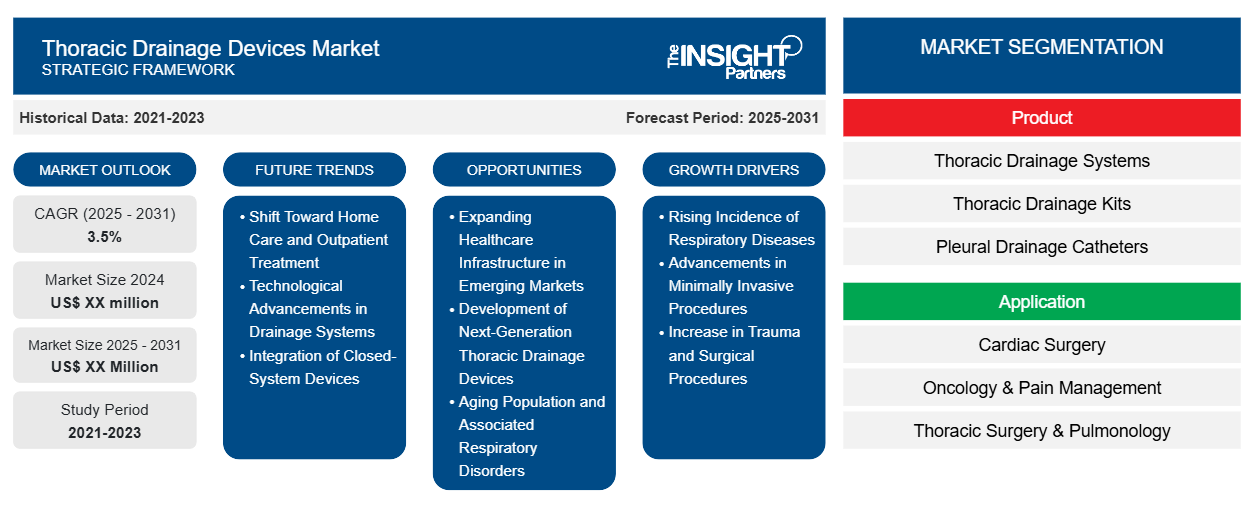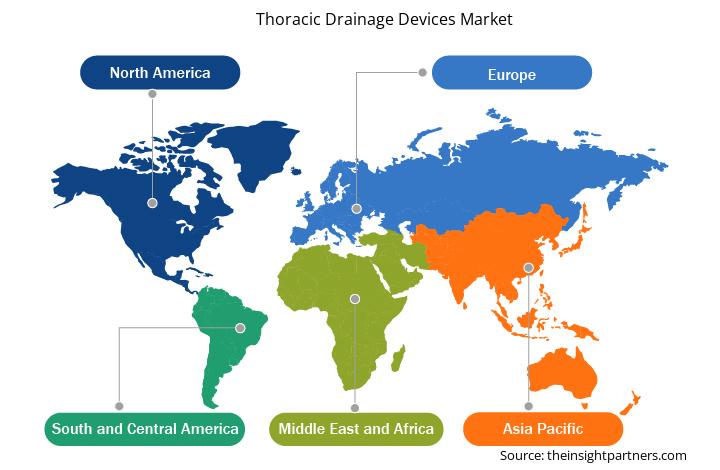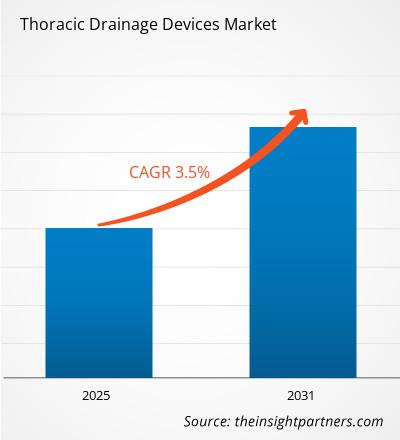The Thoracic Drainage Devices Market is expected to register a CAGR of 3.5% from 2025 to 2031, with a market size expanding from US$ XX million in 2024 to US$ XX Million by 2031.
The report is segmented by Product (Thoracic Drainage Systems, Thoracic Drainage Kits, Pleural Drainage Catheters, Trocar Drains, and Others). The report further presents analysis based on the Application (Cardiac Surgery, Oncology & Pain Management, Thoracic Surgery & Pulmonology, General Intensive Care Emergency Medicine and Others), End-user (Hospitals & Clinics, Ambulatory Surgery Centers, and Others). The global analysis is further broken-down at regional level and major countries. The Report Offers the Value in USD for the above analysis and segments.
Purpose of the Report
The report Thoracic Drainage Devices Market by The Insight Partners aims to describe the present landscape and future growth, top driving factors, challenges, and opportunities. This will provide insights to various business stakeholders, such as:
- Technology Providers/Manufacturers: To understand the evolving market dynamics and know the potential growth opportunities, enabling them to make informed strategic decisions.
- Investors: To conduct a comprehensive trend analysis regarding the market growth rate, market financial projections, and opportunities that exist across the value chain.
- Regulatory bodies: To regulate policies and police activities in the market with the aim of minimizing abuse, preserving investor trust and confidence, and upholding the integrity and stability of the market.
Thoracic Drainage Devices Market SegmentationProduct - Thoracic Drainage Systems
- Thoracic Drainage Kits
- Pleural Drainage Catheters
- Trocar Drains
Application - Cardiac Surgery
- Oncology & Pain Management
- Thoracic Surgery & Pulmonology
- General Intensive Care Emergency Medicine
End-user - Hospitals & Clinics
- Ambulatory Surgery Centers
- Thoracic Drainage Systems
- Thoracic Drainage Kits
- Pleural Drainage Catheters
- Trocar Drains
Application - Cardiac Surgery
- Oncology & Pain Management
- Thoracic Surgery & Pulmonology
- General Intensive Care Emergency Medicine
End-user - Hospitals & Clinics
- Ambulatory Surgery Centers
- Hospitals & Clinics
- Ambulatory Surgery Centers
Customize This Report To Suit Your Requirement
You will get customization on any report - free of charge - including parts of this report, or country-level analysis, Excel Data pack, as well as avail great offers and discounts for start-ups & universities
Thoracic Drainage Devices Market: Strategic Insights

- Get Top Key Market Trends of this report.This FREE sample will include data analysis, ranging from market trends to estimates and forecasts.
Thoracic Drainage Devices Market Growth Drivers- Rising Incidence of Respiratory Diseases: The increasing prevalence of respiratory conditions such as pneumonia, chronic obstructive pulmonary disease (COPD), and lung cancer is driving the demand for thoracic drainage devices. These diseases often result in complications that require thoracic drainage, fueling market growth as healthcare providers seek reliable solutions to manage pleural effusion and other related conditions.
- Advancements in Minimally Invasive Procedures: The growing trend towards minimally invasive surgery in thoracic procedures is a significant driver for the market. Thoracic drainage devices are increasingly used in video-assisted thoracoscopic surgery (VATS), providing a less invasive option for draining fluids or air from the pleural cavity, reducing recovery times and complications for patients, which boosts demand for these devices.
- Increase in Trauma and Surgical Procedures: Thoracic drainage devices are essential in managing trauma and post-surgical complications, such as air or fluid accumulation in the chest cavity. With a growing number of trauma cases, thoracic surgeries, and cardiothoracic procedures, the need for these devices in critical care settings is expanding, propelling the market forward.
Thoracic Drainage Devices Market Future Trends- Shift Toward Home Care and Outpatient Treatment: There is a growing trend of using thoracic drainage devices in outpatient settings and home care. With advancements in technology, devices have become more portable and easier to use outside the hospital, enabling patients to continue their recovery at home, reducing hospital stays, and minimizing healthcare costs.
- Technological Advancements in Drainage Systems: Thoracic drainage devices are becoming more technologically advanced with features such as automated suction control, smart sensors, and digital monitoring. These innovations allow for better management and real-time tracking of drainage, improving patient safety and the accuracy of fluid monitoring, while enhancing the convenience and efficiency of the devices.
- Integration of Closed-System Devices: There is an increasing adoption of closed-system thoracic drainage devices, which prevent contamination and reduce the risk of infections. These systems provide a more sterile environment, ensuring that fluid and air are securely collected and drained, improving patient safety and contributing to the growth of the market, particularly in hospitals and surgical settings.
Thoracic Drainage Devices Market Opportunities- Expanding Healthcare Infrastructure in Emerging Markets: As healthcare infrastructure improves in emerging regions like Asia-Pacific, Latin America, and Africa, the demand for thoracic drainage devices is expected to rise. Increasing healthcare access, combined with rising rates of trauma, respiratory diseases, and surgeries, provides a significant growth opportunity for manufacturers in these regions.
- Development of Next-Generation Thoracic Drainage Devices: There is an opportunity to develop next-generation devices with enhanced features such as wireless monitoring, integrated sensors, and patient-specific customization. These advanced features can lead to better clinical outcomes, improve patient comfort, and enable remote monitoring, representing a key opportunity for innovation in the market.
- Aging Population and Associated Respiratory Disorders: The growing aging population worldwide is at a higher risk for conditions such as pleural effusion, pneumonia, and lung cancer, which often require thoracic drainage. This demographic shift creates an opportunity for medical device companies to target a larger patient population, increasing demand for thoracic drainage devices.
- Shift Toward Home Care and Outpatient Treatment: There is a growing trend of using thoracic drainage devices in outpatient settings and home care. With advancements in technology, devices have become more portable and easier to use outside the hospital, enabling patients to continue their recovery at home, reducing hospital stays, and minimizing healthcare costs.
- Technological Advancements in Drainage Systems: Thoracic drainage devices are becoming more technologically advanced with features such as automated suction control, smart sensors, and digital monitoring. These innovations allow for better management and real-time tracking of drainage, improving patient safety and the accuracy of fluid monitoring, while enhancing the convenience and efficiency of the devices.
- Integration of Closed-System Devices: There is an increasing adoption of closed-system thoracic drainage devices, which prevent contamination and reduce the risk of infections. These systems provide a more sterile environment, ensuring that fluid and air are securely collected and drained, improving patient safety and contributing to the growth of the market, particularly in hospitals and surgical settings.
Thoracic Drainage Devices Market Opportunities- Expanding Healthcare Infrastructure in Emerging Markets: As healthcare infrastructure improves in emerging regions like Asia-Pacific, Latin America, and Africa, the demand for thoracic drainage devices is expected to rise. Increasing healthcare access, combined with rising rates of trauma, respiratory diseases, and surgeries, provides a significant growth opportunity for manufacturers in these regions.
- Development of Next-Generation Thoracic Drainage Devices: There is an opportunity to develop next-generation devices with enhanced features such as wireless monitoring, integrated sensors, and patient-specific customization. These advanced features can lead to better clinical outcomes, improve patient comfort, and enable remote monitoring, representing a key opportunity for innovation in the market.
- Aging Population and Associated Respiratory Disorders: The growing aging population worldwide is at a higher risk for conditions such as pleural effusion, pneumonia, and lung cancer, which often require thoracic drainage. This demographic shift creates an opportunity for medical device companies to target a larger patient population, increasing demand for thoracic drainage devices.
Thoracic Drainage Devices Market Regional Insights
The regional trends and factors influencing the Thoracic Drainage Devices Market throughout the forecast period have been thoroughly explained by the analysts at Insight Partners. This section also discusses Thoracic Drainage Devices Market segments and geography across North America, Europe, Asia Pacific, Middle East and Africa, and South and Central America.

- Get the Regional Specific Data for Thoracic Drainage Devices Market
Thoracic Drainage Devices Market Report Scope
| Report Attribute | Details |
|---|---|
| Market size in 2024 | US$ XX million |
| Market Size by 2031 | US$ XX Million |
| Global CAGR (2025 - 2031) | 3.5% |
| Historical Data | 2021-2023 |
| Forecast period | 2025-2031 |
| Segments Covered |
By Product
|
| Regions and Countries Covered | North America
|
| Market leaders and key company profiles |
Thoracic Drainage Devices Market Players Density: Understanding Its Impact on Business Dynamics
The Thoracic Drainage Devices Market market is growing rapidly, driven by increasing end-user demand due to factors such as evolving consumer preferences, technological advancements, and greater awareness of the product's benefits. As demand rises, businesses are expanding their offerings, innovating to meet consumer needs, and capitalizing on emerging trends, which further fuels market growth.
Market players density refers to the distribution of firms or companies operating within a particular market or industry. It indicates how many competitors (market players) are present in a given market space relative to its size or total market value.
Major Companies operating in the Thoracic Drainage Devices Market are:
- Medtronic
- Smith & Nephew
- Cook Medical
- Halyard Health (now part of Owens & Minor)
- Teleflex Incorporated
- AngioDynamics
Disclaimer: The companies listed above are not ranked in any particular order.

- Get the Thoracic Drainage Devices Market top key players overview
Key Selling Points- Comprehensive Coverage: The report comprehensively covers the analysis of products, services, types, and end users of the Thoracic Drainage Devices Market, providing a holistic landscape.
- Expert Analysis: The report is compiled based on the in-depth understanding of industry experts and analysts.
- Up-to-date Information: The report assures business relevance due to its coverage of recent information and data trends.
- Customization Options: This report can be customized to cater to specific client requirements and suit the business strategies aptly.
The research report on the Thoracic Drainage Devices Market can, therefore, help spearhead the trail of decoding and understanding the industry scenario and growth prospects. Although there can be a few valid concerns, the overall benefits of this report tend to outweigh the disadvantages.
Frequently Asked Questions
What types of conditions require thoracic drainage devices?
Thoracic drainage devices are primarily used in the management of pleural effusion, pneumothorax, post-surgical drainage, and trauma cases. Conditions such as lung cancer, pneumonia, and chronic obstructive pulmonary disease (COPD) often lead to fluid accumulation in the chest cavity, requiring thoracic drainage to prevent complications and support recovery.
How do technological advancements impact thoracic drainage devices?
Technological advancements have led to the development of smarter and safer thoracic drainage devices. Features like automated suction control, integrated sensors, and real-time monitoring help improve the accuracy of fluid drainage, ensure better patient outcomes, and reduce the risk of complications, all of which enhance the value of these devices in clinical settings.
What are the key advantages of closed-system drainage devices?
Closed-system drainage devices are designed to minimize the risk of infection and contamination. By keeping the system sealed and preventing air and fluid from escaping into the external environment, these devices improve sterility, reduce complications, and enhance patient safety, particularly in hospitals and intensive care settings.
What is driving the demand for thoracic drainage devices in home care?
The trend towards home care is driven by advancements in device technology, making thoracic drainage more portable and easy to use outside the hospital. With features like automated suction, these devices allow patients to continue their recovery at home, improving quality of life and reducing hospital stays, thereby driving market demand in home care settings.
What impact does the aging population have on the thoracic drainage device market?
The aging population is more prone to respiratory diseases, cancer, and trauma, all of which may require thoracic drainage. As the global population ages, particularly in developed regions, the demand for thoracic drainage devices is expected to increase, creating significant market opportunities for manufacturers to cater to this growing patient demographic.
What opportunities exist for manufacturers in emerging markets?
Emerging markets offer substantial growth opportunities for thoracic drainage device manufacturers due to expanding healthcare infrastructure, rising disease prevalence, and increasing surgical interventions. Regions such as Asia-Pacific, Latin America, and Africa present untapped markets, where rising healthcare investments and improved access to medical technologies drive demand for thoracic drainage solutions.
- Historical Analysis (2 Years), Base Year, Forecast (7 Years) with CAGR
- PEST and SWOT Analysis
- Market Size Value / Volume - Global, Regional, Country
- Industry and Competitive Landscape
- Excel Dataset
Testimonials
Reason to Buy
- Informed Decision-Making
- Understanding Market Dynamics
- Competitive Analysis
- Identifying Emerging Markets
- Customer Insights
- Market Forecasts
- Risk Mitigation
- Boosting Operational Efficiency
- Strategic Planning
- Investment Justification
- Tracking Industry Innovations
- Aligning with Regulatory Trends
Yes! We provide a free sample of the report, which includes Report Scope (Table of Contents), report structure, and selected insights to help you assess the value of the full report. Please click on the "Download Sample" button or contact us to receive your copy.
Absolutely — analyst assistance is part of the package. You can connect with our analyst post-purchase to clarify report insights, methodology or discuss how the findings apply to your business needs.
Once your order is successfully placed, you will receive a confirmation email along with your invoice.
• For published reports: You’ll receive access to the report within 4–6 working hours via a secured email sent to your email.
• For upcoming reports: Your order will be recorded as a pre-booking. Our team will share the estimated release date and keep you informed of any updates. As soon as the report is published, it will be delivered to your registered email.
We offer customization options to align the report with your specific objectives. Whether you need deeper insights into a particular region, industry segment, competitor analysis, or data cut, our research team can tailor the report accordingly. Please share your requirements with us, and we’ll be happy to provide a customized proposal or scope.
The report is available in either PDF format or as an Excel dataset, depending on the license you choose.
The PDF version provides the full analysis and visuals in a ready-to-read format. The Excel dataset includes all underlying data tables for easy manipulation and further analysis.
Please review the license options at checkout or contact us to confirm which formats are included with your purchase.
Our payment process is fully secure and PCI-DSS compliant.
We use trusted and encrypted payment gateways to ensure that all transactions are protected with industry-standard SSL encryption. Your payment details are never stored on our servers and are handled securely by certified third-party processors.
You can make your purchase with confidence, knowing your personal and financial information is safe with us.
Yes, we do offer special pricing for bulk purchases.
If you're interested in purchasing multiple reports, we’re happy to provide a customized bundle offer or volume-based discount tailored to your needs. Please contact our sales team with the list of reports you’re considering, and we’ll share a personalized quote.
Yes, absolutely.
Our team is available to help you make an informed decision. Whether you have questions about the report’s scope, methodology, customization options, or which license suits you best, we’re here to assist. Please reach out to us at sales@theinsightpartners.com, and one of our representatives will get in touch promptly.
Yes, a billing invoice will be automatically generated and sent to your registered email upon successful completion of your purchase.
If you need the invoice in a specific format or require additional details (such as company name, GST, or VAT information), feel free to contact us, and we’ll be happy to assist.
Yes, certainly.
If you encounter any difficulties accessing or receiving your report, our support team is ready to assist you. Simply reach out to us via email or live chat with your order information, and we’ll ensure the issue is resolved quickly so you can access your report without interruption.















- Medtronic
- Smith & Nephew
- Cook Medical
- Halyard Health (now part of Owens & Minor)
- Teleflex Incorporated
- AngioDynamics
- Johnson & Johnson (Ethicon)
- BD (Becton, Dickinson and Company)
- ConvaTec Group
- M?lnlycke Health Care






 Get Free Sample For
Get Free Sample For